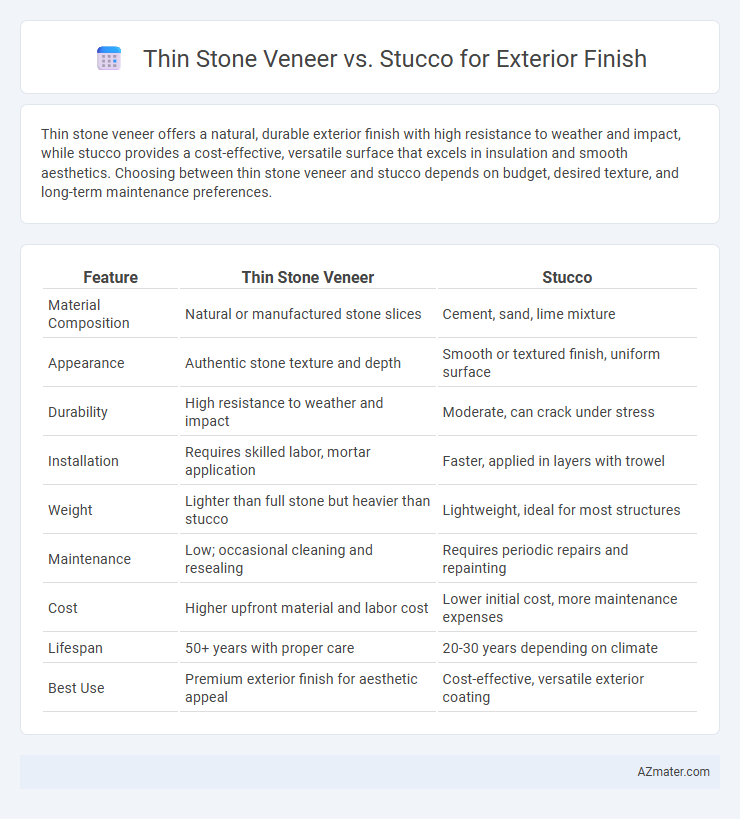Thin stone veneer offers a natural, durable exterior finish with high resistance to weather and impact, while stucco provides a cost-effective, versatile surface that excels in insulation and smooth aesthetics. Choosing between thin stone veneer and stucco depends on budget, desired texture, and long-term maintenance preferences.
Table of Comparison
| Feature | Thin Stone Veneer | Stucco |
|---|---|---|
| Material Composition | Natural or manufactured stone slices | Cement, sand, lime mixture |
| Appearance | Authentic stone texture and depth | Smooth or textured finish, uniform surface |
| Durability | High resistance to weather and impact | Moderate, can crack under stress |
| Installation | Requires skilled labor, mortar application | Faster, applied in layers with trowel |
| Weight | Lighter than full stone but heavier than stucco | Lightweight, ideal for most structures |
| Maintenance | Low; occasional cleaning and resealing | Requires periodic repairs and repainting |
| Cost | Higher upfront material and labor cost | Lower initial cost, more maintenance expenses |
| Lifespan | 50+ years with proper care | 20-30 years depending on climate |
| Best Use | Premium exterior finish for aesthetic appeal | Cost-effective, versatile exterior coating |
Introduction to Exterior Finishes: Thin Stone Veneer vs Stucco
Thin stone veneer offers a natural, textured appearance with durable stone materials that enhance curb appeal and provide long-lasting protection against weather elements. Stucco, a cement-based exterior finish, delivers a smooth or textured surface that is cost-effective, versatile in design, and known for its excellent weather resistance and energy efficiency. Choosing between thin stone veneer and stucco depends on factors like aesthetic preference, budget, climate considerations, and maintenance requirements for exterior finishes.
Material Composition: What Is Thin Stone Veneer?
Thin stone veneer consists of natural or manufactured stone cut into lightweight, thin slices typically ranging from 1/2 to 1 1/2 inches thick, designed for easy application over exterior surfaces. It offers the authentic texture and appearance of full-thickness stone without the structural weight, composed primarily of quarried stone or cast concrete materials with mineral pigments for realistic finishes. This material combines durability and aesthetic appeal, providing a weather-resistant exterior finish option often preferred over traditional stucco, which is a cement-based plaster applied in multiple layers.
Understanding Stucco: Traditional and Modern Formulations
Stucco, a durable exterior finish, is composed of cement, sand, lime, and water, with traditional formulations relying on lime-based mixtures for breathability and flexibility. Modern stucco incorporates acrylic polymers to enhance water resistance, adhesion, and impact durability, making it suitable for diverse climates. Compared to thin stone veneer, stucco offers a seamless, cost-effective finish but requires proper curing and maintenance to prevent cracking and water intrusion.
Visual Appeal and Aesthetic Versatility
Thin stone veneer offers a natural, textured appearance that enhances curb appeal with its realistic stone look, providing rich color variations and depth suitable for traditional and rustic designs. Stucco delivers a smooth, uniform finish that can be tinted in a wide range of colors and textures, allowing greater flexibility for modern, Mediterranean, or Southwestern aesthetics. Both materials significantly impact exterior visual appeal, but thin stone veneer adds dimensionality while stucco excels in customizable surface treatments.
Installation Process: Comparing Techniques and Complexity
Thin stone veneer installation involves attaching lightweight stone pieces to a prepared substrate using mortar or adhesive, requiring skill in cutting and fitting each stone precisely for a natural appearance. Stucco application consists of multiple layers--scratch coat, brown coat, and finish coat--applied over metal lath and requires adequate curing time to ensure durability and cracking resistance. Thin stone veneer demands more detailed craftsmanship and longer installation time, whereas stucco offers a faster process with the necessity for controlled environmental conditions during curing.
Cost Differences: Initial Investment and Long-Term Value
Thin stone veneer generally requires a higher initial investment compared to stucco due to material and installation costs, often ranging from $15 to $30 per square foot versus stucco's $6 to $12. Long-term value favors thin stone veneer as it offers greater durability, resistance to weather, and low maintenance, potentially reducing repair expenses over time. Stucco may require periodic repainting and patching, increasing lifecycle costs despite its lower upfront price.
Durability and Maintenance Requirements
Thin stone veneer offers superior durability with resistance to impact, weathering, and fading, making it ideal for long-lasting exterior finishes with minimal maintenance beyond occasional cleaning. Stucco, while providing a versatile and cost-effective facade, requires regular inspection and maintenance to prevent cracking and water infiltration, especially in regions with freeze-thaw cycles. Both materials benefit from proper installation, but thin stone veneer generally demands less frequent repairs compared to stucco's need for periodic patching and repainting.
Weather Resistance and Performance
Thin stone veneer offers superior weather resistance with its natural stone composition, providing durable protection against rain, wind, and freeze-thaw cycles, making it ideal for harsh climates. Stucco, while cost-effective and versatile, tends to be more susceptible to cracking and water infiltration if not properly applied or maintained. Performance-wise, thin stone veneer maintains its structural integrity and aesthetic appeal longer under extreme weather conditions compared to stucco, which may require frequent repairs and sealing.
Energy Efficiency and Insulation Properties
Thin stone veneer provides superior thermal mass, helping regulate indoor temperatures by absorbing and slowly releasing heat, which enhances energy efficiency. Stucco offers excellent insulation properties, especially when combined with foam backer boards, reducing heat transfer and improving building envelope performance. Both finishes contribute to energy savings, but thin stone veneer excels in thermal regulation, while stucco provides more consistent insulation.
Choosing the Right Finish: Factors to Consider
Thin stone veneer offers a natural, textured appearance with high durability and low maintenance, ideal for areas prone to weather exposure. Stucco provides a versatile, cost-effective finish with excellent insulation properties, suitable for various architectural styles and climates. Consider factors such as climate, budget, aesthetic preference, maintenance requirements, and installation complexity when selecting between thin stone veneer and stucco for exterior finishes.

Infographic: Thin stone veneer vs Stucco for Exterior finish
 azmater.com
azmater.com